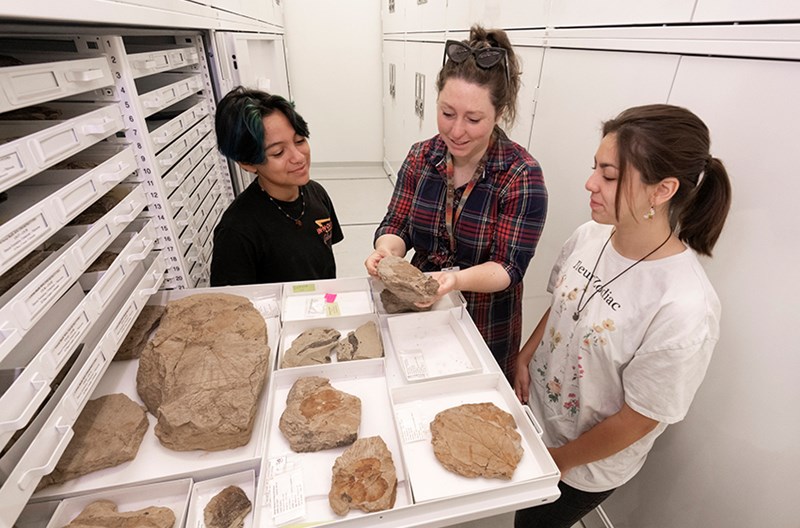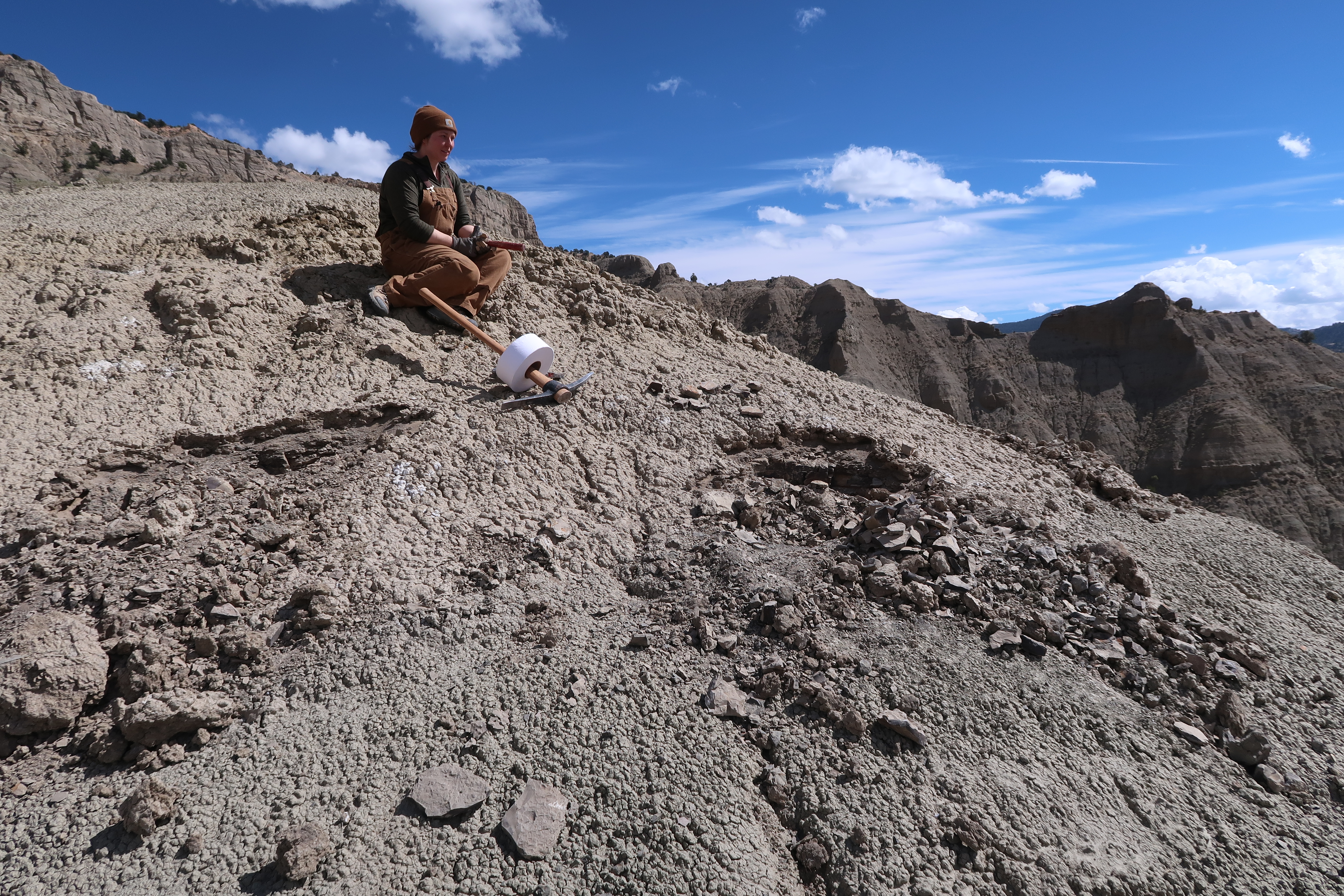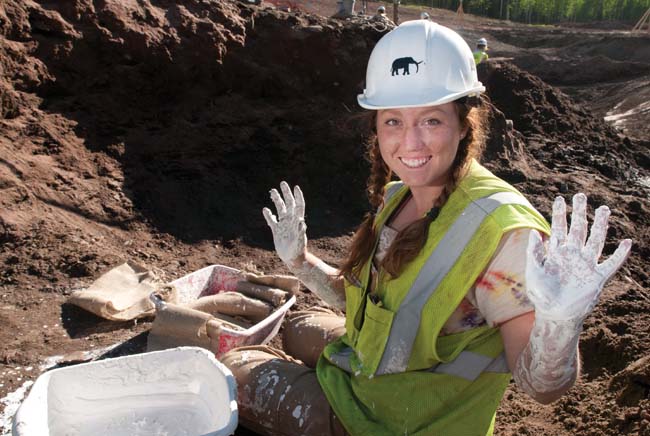
The Denver Museum of Nature & Science is pleased to welcome Dr. Gussie Maccracken as the new Curator of Paleobotany. Dr. Maccracken is an American paleobotanist and is a question-driven scientist with a broad knowledge of different plant and insect groups and has a profound interest in the evolution of plants, herbivorous insects and their interactions in the fossil record.
Before assuming the role of curator, Dr. Maccracken was a National Science Foundation Postdoctoral fellow, specializing on plant–insect ecological interactions throughout the Cretaceous-Paleogene mass extinction.

Dr. Gussie Maccracken examining fossil leaf specimens in the DMNS Paleobotany Collections with Teen Science Scholars Mylo and Mary at the Denver Museum of Nature & Science. (Rick Wicker/ DMNS)
She received her Bachelor’s degree in Biology from Colorado College in 2011 and earned her PhD from the Department of Entomology at the University of Maryland, College Park. Dr. Maccracken’s work experience includes teaching laboratories for undergraduate students at University of Maryland and conducting research at the Smithsonian Institution National Museum of Natural History, as well as working at the Denver Museum of Nature & Science’s fossil preparation laboratory; Gussie knows the Museum well because she had earlier stints from 2010-2013 as a Paleobotany Intern, Snowmastodon Intern, Snowmastodon Preparation Assistant, Fossil Lab Technician and Assistant Fossil Preparator. She is true Museum success story who regards the Curator of Paleobotany position to be her ultimate dream job.
We sat down with Dr. Maccracken and asked her a couple questions:

Gussie at a Late Cretaceous fossil plant site in the Grand Staircase-Escalante National Monument, Utah. (Photo/Ian Miller)
What do you do as a scientist?
I study the evolution of plants using their fossil record. My research focuses on how plants shaped past environments and how plants interacted with animals, such as the mammals and insects that ate these ancient plants. To do this work, I start by finding and digging the plant fossils from the ground, bringing them to the museum to be cared for and then collecting data on them. My research is focused on the Age of the Dinosaurs, also known as the Cretaceous, and immediately after the extinction of the dinosaurs 66-million years ago.
What are you most passionate about in your field or life?
Humans are a part of nature whether we realize it or not and I want to use paleontology to understand how the Earth has changed through time in order to understand the impacts of human activities on our planet.
What are you currently working on? Can you name a few research projects?


- (Picture 1 credit) A view of Corral Bluffs, Colorado Springs, CO. (Photo/Gussie Maccracken)
- (Picture 2 credit) Dr. Maccracken digging a fossil leaf quarry in the Grand Staircase-Escalante National Monument, Utah. (Photo/ Ian Miller)
I'm currently working on two big projects:
- Corral Bluffs, Colorado Springs (first photo): Examining the diversity and types of plants at the end of the Cretaceous (Age of Dinosaurs) and into the first million years of the Paleogene (Age of Mammals).
- Laramidia Project (second photo): exploring fossil plants from approximately 75-million years ago in western North America (Late Cretaceous) to reconstruct ancient ecosystems during the Age of the Dinosaurs.
In three words or less, what would you say your expertise is?
Fossil plants

Gussie Maccracken admiring an enormous Gunnera leaf in Costa Rica. (Photo/Gussie Maccracken)
What is your favorite memory from the field?
My favorite memory is from a fieldtrip in 2012 where we found 76-million-year-old leaves from the Kaiparowits Formation, Grand Staircase-Escalante National Monument, Utah. We had scaled up some exciting ridges in the badlands which produced some of the most amazing views of the monument. Between hammering away at the rock and finding spectacular fossil leaves, there was a moment when I realized I wanted to do this for the rest of my life. It was certainly a turning point for me and I’ve never looked back.
What is your favorite hobby?
I enjoy walking and hiking with my husband throughout Colorado.
What is your favorite animal or dinosaur?
My favorite animal is the Leaf cutter bee, and my favorite dinosaur group is the Therizinosaurs. They were likely herbivorous theropods (a group that includes T. rex) and they are some of the goofiest looking dinosaurs.
What do you look forward to in your new Museum position?
I'm excited to dig fossil leaves all over Colorado to understand how ancient landscapes changed through time in our own backyard. I study the evolution of plants using their fossil record. My research focuses on how plants shaped past environments and how plants interacted with animals, such as the mammals and insects that ate these ancient plants. Humans are a part of nature whether we realize it or not and I want to use paleontology to understand how the Earth has changed through time to understand the impacts of human activities on our planet.

Intern #9 (Dr. Maccracken) in 2011 making a plaster field jacket at the Snowmastodon Dig in Snowmass Village, CO. Image credit: (Photo/Rick Wicker, DMNS)
What are your top publications?
- Maccracken SA, Miller IM, Johnson KR, Sertich JJW, & Labandeira CC. 2022. Insect herbivory on Catula gettyi gen. et sp. nov. (Lauraceae) from the Kaiparowits Formation (Late Cretaceous, Utah, USA). PLoS ONE. 17(1), e0261397.
- Maccracken SA, Sohn J–C, Miller IM, & Labandeira CC. 2021. A new Late Cretaceous leaf mine Leucopteropsa spiralae gen. et sp. nov. (Lepidoptera: Lyonetiidae) represents the first confirmed fossil evidence of the Cemiostominae. Journal of Systematic Palaeontology. 19(2), 131–144.
- Maccracken SA, Miller IM, & Labandeira CC. 2019. Late Cretaceous Domatia Reveals the Antiquity of Plant–Mite Mutualisms in Flowering Plants. Biology Letters. 15(11), 20190657.
- Lyson TR, Miller IM, Bercovici AD, Weissenburger K, Fuentes AJ, Clyde WC, Hagadorn JW, Butrim MJ, Johnson KR, Fleming RF, Barclay RS, Maccracken SA, Lloyd B, Wilson GP, Krause DW, & Chester SGB. 2019. An Exceptional Continental Record of Biotic Recovery after the Cretaceous–Paleogene Mass Extinction. Science. eaay-2268.
- Currano ED, Azevedo-Schmidt LE*, Maccracken SA*, Swain A*. 2021. Scars on fossil leaves: An exploration of ecological patterns in plant–insect herbivore associations during the Age of Angiosperms. Palaeogeography, Palaeoclimatology, Palaeoecology. 582, 110636. *Authors contributed equally.
Can we follow you on social media?
Of course! My social media handles are:
- Instagram: @paleogussie
- Twitter: @Gussie_Mac
